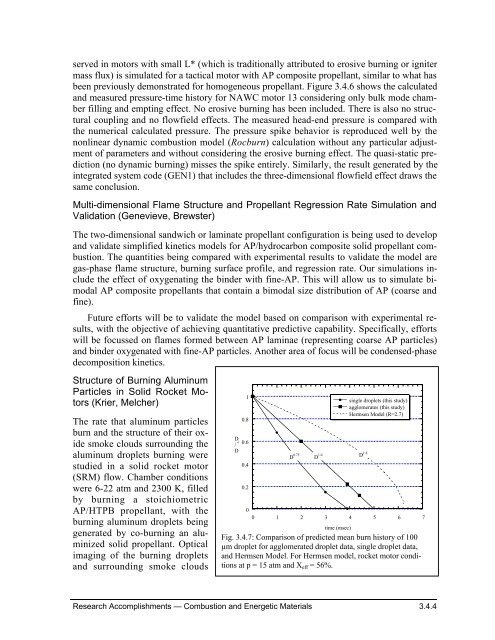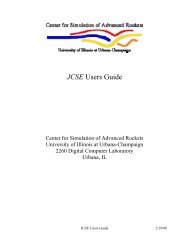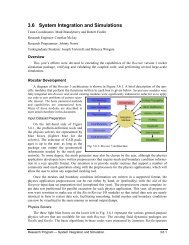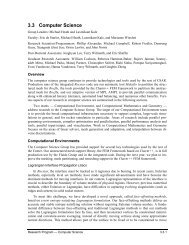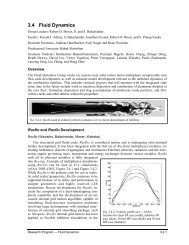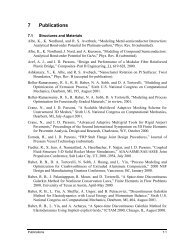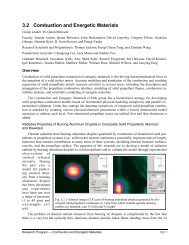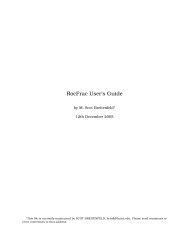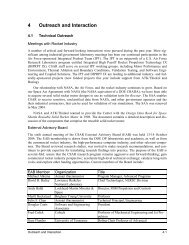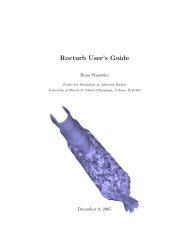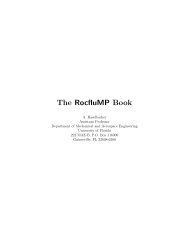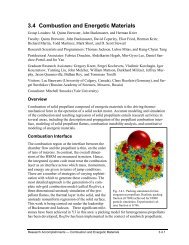3.4 Combustion and Energetic Materials
3.4 Combustion and Energetic Materials
3.4 Combustion and Energetic Materials
Create successful ePaper yourself
Turn your PDF publications into a flip-book with our unique Google optimized e-Paper software.
served in motors with small L* (which is traditionally attributed to erosive burning or igniter<br />
mass flux) is simulated for a tactical motor with AP composite propellant, similar to what has<br />
been previously demonstrated for homogeneous propellant. Figure <strong>3.4</strong>.6 shows the calculated<br />
<strong>and</strong> measured pressure-time history for NAWC motor 13 considering only bulk mode chamber<br />
filling <strong>and</strong> empting effect. No erosive burning has been included. There is also no structural<br />
coupling <strong>and</strong> no flowfield effects. The measured head-end pressure is compared with<br />
the numerical calculated pressure. The pressure spike behavior is reproduced well by the<br />
nonlinear dynamic combustion model (Rocburn) calculation without any particular adjustment<br />
of parameters <strong>and</strong> without considering the erosive burning effect. The quasi-static prediction<br />
(no dynamic burning) misses the spike entirely. Similarly, the result generated by the<br />
integrated system code (GEN1) that includes the three-dimensional flowfield effect draws the<br />
same conclusion.<br />
Multi-dimensional Flame Structure <strong>and</strong> Propellant Regression Rate Simulation <strong>and</strong><br />
Validation (Genevieve, Brewster)<br />
The two-dimensional s<strong>and</strong>wich or laminate propellant configuration is being used to develop<br />
<strong>and</strong> validate simplified kinetics models for AP/hydrocarbon composite solid propellant combustion.<br />
The quantities being compared with experimental results to validate the model are<br />
gas-phase flame structure, burning surface profile, <strong>and</strong> regression rate. Our simulations include<br />
the effect of oxygenating the binder with fine-AP. This will allow us to simulate bimodal<br />
AP composite propellants that contain a bimodal size distribution of AP (coarse <strong>and</strong><br />
fine).<br />
Future efforts will be to validate the model based on comparison with experimental results,<br />
with the objective of achieving quantitative predictive capability. Specifically, efforts<br />
will be focussed on flames formed between AP laminae (representing coarse AP particles)<br />
<strong>and</strong> binder oxygenated with fine-AP particles. Another area of focus will be condensed-phase<br />
decomposition kinetics.<br />
Structure of Burning Aluminum<br />
Particles in Solid Rocket Motors<br />
(Krier, Melcher)<br />
The rate that aluminum particles<br />
burn <strong>and</strong> the structure of their oxide<br />
smoke clouds surrounding the<br />
aluminum droplets burning were<br />
studied in a solid rocket motor<br />
(SRM) flow. Chamber conditions<br />
were 6-22 atm <strong>and</strong> 2300 K, filled<br />
by burning a stoichiometric<br />
AP/HTPB propellant, with the<br />
burning aluminum droplets being<br />
generated by co-burning an aluminized<br />
solid propellant. Optical<br />
imaging of the burning droplets<br />
<strong>and</strong> surrounding smoke clouds<br />
D o<br />
/<br />
D<br />
1<br />
0.8<br />
0.6<br />
0.4<br />
0.2<br />
D 0.75 1.0 D1.8<br />
D<br />
single droplets (this study)<br />
agglomerates (this study)<br />
Hermsen Model (R=2.7)<br />
0<br />
0 1 2 3 4 5 6 7<br />
time (msec)<br />
Fig. <strong>3.4</strong>.7: Comparison of predicted mean burn history of 100<br />
µm droplet for agglomerated droplet data, single droplet data,<br />
<strong>and</strong> Hermsen Model. For Hermsen model, rocket motor conditions<br />
at pÊ=Ê15Êatm <strong>and</strong> X eff Ê=Ê56%.<br />
ðResearch Accomplishments Ñ <strong>Combustion</strong> <strong>and</strong> <strong>Energetic</strong> <strong>Materials</strong> <strong>3.4</strong>.4


